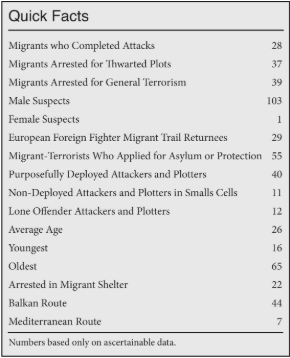The Center for Immigration Studies published the results of a yearlong study of migrants who crossed Europe’s external borders and conducted attacks or who were arrested and killed committing terrorism crimes. This paper quantifies for the first time how many border-crossing migrants attacked in Europe and analyzes consequences for U.S. border security, among them: a moderate, high-consequence threat of similar infiltration.
This study was serialized in four parts and published by the news and opinion website Townhall. That series can be found here.
CIS rolled out the study November 6, 2019 during a Question and Answer panel at the National Press Club. Video of that event can be found here.

KEY FINDINGS:
- At least 104 Islamist extremists entered the European Union’s (EU) external borders using long-haul irregular migration methods between 2014-2018, establishing proof of concept for a previously theoretical terrorism travel tactic over borders.
- Of the 104 migrant terrorists identified for the 2014-2018 period, 28 successfully completed attacks that claimed the lives of 170 victims and wounded 878. An additional 37 were arrested or killed plotting attacks, and 39 others were arrested for illegal involvement with foreign terrorist organizations.
- A majority of the 104 terrorists applied for international protections such as asylum and were able to remain in European nations for an average of 11 months before attacks or arrests for plots, demonstrating that asylum processes accommodated plot incubation.
- While total numbers of migrant-terrorists were a fraction of overall irregular migration, their activities demonstrate that small numbers present outsized threats to the United States should only a few strike here. In Europe, a relative few upended longstanding political power balances, prompted a major military campaign, forced massive public expenditures on new security policies, prompted the British vote to exit the European Union, and disrupted the free movement of people within the Schengen zone.
- American security and counter-terrorism intelligence measures likely have prevented some migrant-terrorists from conducting attacks and may partly explain the absence of attacks to date from over the U.S. southern border. However, an elevated threat of terrorist infiltration via the border persists due to neglect and exploitable flaws in the American measures.

An interactive map of all the migrant-terror incidents is available in the report, which can be read here.
Introduction

In September 2018, the White House released its “National Strategy for Counterterrorism”, outlining the nation’s new counterterrorism priorities since 2011. This was the latest iteration of a tradition that President George W. Bush started after 9/11, of breaking out the terrorism threat from the broader National Security Strategy in February 2003.3 An update was appropriate because, since the last one in June 2011, much in the threat landscape had drastically changed with, for instance, the failure of the “Arab Spring”, and the rise and fall of an ISIS “caliphate” in Syria.
An entirely new phenomenon on the contemporary threat stage found its way to a prominent place in the 2018 White House’s National Strategy for Counterterrorism, though almost completely unremarked upon since. The strategy observed that over the previous few years, Islamist terrorists had, “to great effect”, infiltrated European land borders “by capitalizing on the migrant crisis to seed attack operatives into the region.”4 The document went on to frame the infiltration events of Europe as a replicable prospect for the American southern land border:
Europe’s struggle to screen the people crossing its borders highlights the importance of ensuring strong United States borders so that terrorists cannot enter the United States.5
Between 2014 and 2017, 13 of the 26 member states lining the so-called Schengen Area’s external ¬land borders recorded more than 2.5 million detections of illegal border-crossings along several land and sea routes, an historic, mostly unfettered surge that came to be known as the “migrant crisis”.6 The Schengen Area, which generally encompasses the European Union, consists of countries that combined immigration enforcement of a common external border of 27,000 sea miles and 5,500 land miles while removing all interior border controls to facilitate the free movement of goods and people.7

During the 2014-2018 migrant crisis, the majority of travelers who crossed the external border and were then able to move unfettered between member nations came from nations in the Middle East, such as Syria and Iraq; South Asia, such as Afghanistan and Pakistan; and Africa, such as Somalia and Eritrea.8 It first became known that some ISIS terrorist operatives also were in the flows after some of them committed the November 2015 Paris attacks cited in the White House strategy, and then the March 2016 Brussels attacks.9
The White House strategy cited the prospect of Europe-style terrorist border infiltration at the American border to support various U.S. strategic goals such as: “Our borders and all ports of entry into the United States are secure against terrorist threats,” and to “enhance detection and disruption of terrorist travel” by working with foreign partners to “prevent terrorists fleeing conflict zones from infiltrating civilian populations.”10
The strategy document, however, faltered somewhat in citing sufficient supporting evidence for its idea that the European experience carried implications for U.S. border security, offering only that “two of the perpetrators of the 2015 ISIS attacks in Paris, France, infiltrated the country posing as migrants.” Open sources were already showing considerably higher numbers than “two”, but, to be fair, no concerted public-realm effort to quantify the total or analyze its meaning had occurred at that point in time.11 Other migrants in Europe were implicated in terror attacks, plots, and involvement with legally banned terrorist groups. Some had been European citizens fighting with ISIS in Syria who posed as refugees to enable clandestine entry, while others were from countries where Islamist terrorist organizations and ideologies are present.

Absent quantified analysis, electorates and leaderships have not widely acknowledged that a new innovation in terror travel had emerged, with implications for the United States. Some reporting has better quantified how often terrorists used migration methods to breach European borders, notably by researcher Sam Mullins of the George C. Marshall European Center for Security Studies and by Robin Simcox of the Heritage Foundation.12 But the totality of how migration and terrorism intertwined as a destructive force against Europe, and the continent’s response, remains largely unacknowledged, undocumented, and not analyzed.
The purpose of this report is to further document the extent of Europe’s migrant-terrorism experience, to analyze the U.S. threat, and identify European security responses that might be applicable to U.S. border security strategy.

Methodology
A key study objective was to account for the numbers of suspected terrorists who used irregular overland migration to breach European borders and who were then implicated in terroristic activities between 2014-2018, with as high a degree of probability as public reporting would permit.13 It is based on an NVIVO software-managed collection of approximately 480 media and government reports that were individually analyzed to answer the research questions.14 Much information regarding individual suspects remained behind law enforcement and intelligence firewalls. Therefore, the bulk of data for this study had to be derived from imperfect media and unclassified government reporting, a factor this study considered in its data analysis. Media reports, for instance, sometimes proved incomplete or were not updated to confirm how individuals traveled and entered the EU, or what became of their cases. European law enforcement often withheld complete names of perpetrators. This report attempted to ascribe confidence to whether specific terrorist suspects should be counted as having reached Europe via overland migration or applied for asylum and how the adjudication processes unfolded. Judgments therefore had to be made, possibly error-prone, to count individuals based on the totality and quality of reporting. Cases were categorized as “medium possibility”, “strong probability”, and “confirmed”. Only those rated “strong probability” and “confirmed” were counted.15
This study also sought to determine the volumes and types of “terrorism events” to which the migrant-terrorist suspects could be attributed. These were defined and categorized as “completed attacks”, “thwarted plots”, and finally “arrests/prosecutions” for illegal extremist activities not associated with any known thwarted plot or completed attack. Among those in this latter group, for instance, were migrants prosecuted for obfuscating illegal past participation in legally banned terrorist groups or having committed acts of violence elsewhere on behalf of such groups.